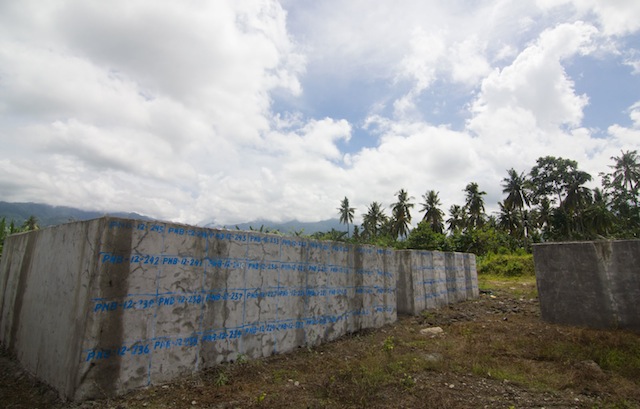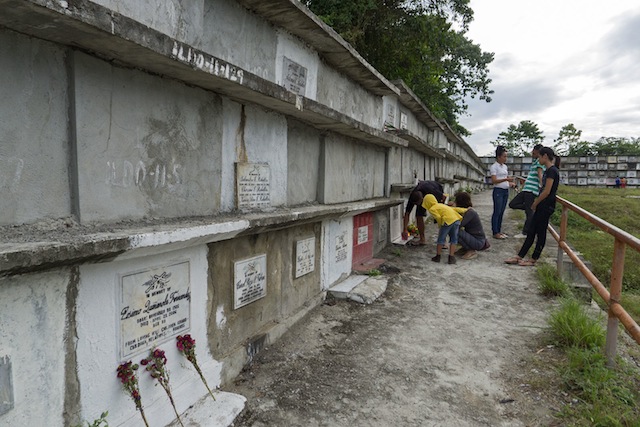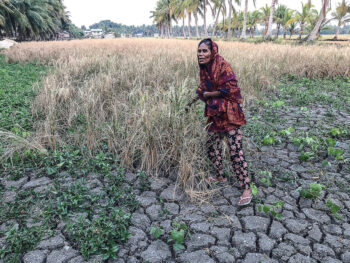NEW BATAAN, Compostela Valley (MindaNews / 02 November) — Sila man tung wala nailhan” (They were the ones who were not identified), a man on a motorbike told his companion shortly before noon Saturday, as they passed four concrete structures at the public cemetery in Purok 4, Barangay Cabinuangan, rows and columns painted in phthalein blue with the initials “PNB,” followed by numbers.
The concrete burial vaults have108 individual niches and 12 compartments that could accommodate 30 bodies each. They contain the remains of at least 300 residents who were killed when super typhoon Pablo slammed across this town on December 4, 2012, and are now known only by the numbers assigned to them, preceded by the code “PNB-12” for “Pablo New Bataan 2012.”
 NUMBERED. The public cemetery in New Bataan, Compostela Valley has four concrete burial vaults where the unidentified victims of super typhoon Pablo on December 4, 2012 were buried. Their individual niches are numbered, preceded by the code PNB-12 for “Pablo New Bataan, 2012.” who perished in Typhoon Pablo on December 4, 2012 are marked by numbers in this photo taken on November 1, 2014 at a public cemetery in New Bataan, Compostela Valley. MindaNews photo by Toto Lozano
NUMBERED. The public cemetery in New Bataan, Compostela Valley has four concrete burial vaults where the unidentified victims of super typhoon Pablo on December 4, 2012 were buried. Their individual niches are numbered, preceded by the code PNB-12 for “Pablo New Bataan, 2012.” who perished in Typhoon Pablo on December 4, 2012 are marked by numbers in this photo taken on November 1, 2014 at a public cemetery in New Bataan, Compostela Valley. MindaNews photo by Toto Lozano
DNA samplings had been taken from these “numbers” and they are supposed to be matched with DNA results taken from their relatives who survived.
Ideally, if the DNA results find a match, the victim ceases to be a number and regains his/her identity. Ideally.
But nearly two years after Pablo and nearly three years after Sendong, relatives are still waiting for the National Bureau of Investigation (NBI) to release the results of the DNA matching.
Thirty-year old Dennis Pasigna of Purok 4 in Barangay Andap is among those waiting.
The farmer-turned-municipal utility worker initially thought he had lost his entire family, having seen his wife, Mildred, then 20, and his youngest son, Earl John, 2, swept away by the debris flow – a combination of water, mud, rocks, boulders, houses and trees – and how the force of the flow separated him from his eldest son Reniel.
Father and son Reniel, now 6, were reunited in a hospital in Tagum City four days later.
Aside from his wife and youngest son, Dennis’ mother, Antonia; his father, Santiago; and younger brother Johnny are still “missing.”
They may actually have been among the bodies buried in the vaults, unclaimed by relatives because they were beyond recognition.
Six months
Pasigna recalls that the Disaster Victim Identification (DVI) team of the National Bureau of Investigation (NBI) came to get their DNA samplings – he doesn’t recall when but says it must have been in January 2013. What he distinctly remembers is that the DVI team told them the results would be out in six months. He said the team got their mobile numbers. “Dili pwede kung wala celfone number” (It was mandatory to have a celfone number), they were told, because if they moved out of New Bataan, the DVI team would still have a means of communicating with them.
Nearly two years later, Pasigna has yet to hear from the NBI-DVI.
New Bataan Information Officer Marlon Esperanza told MindaNews that the Municipal Health Officer, Dr. Aurea Sollilap, had repeatedly checked with the NBI for the results.
Sollilap told MindaNews on October 7 that two weeks earlier, she followed up the NBI about the DNA matching results but was told they were not available yet.
“They told me they will inform me when the results are available,” she said. MindaNews checked again on October 29 but Sollilap said the NBi has not released the results.
Budgetary constraints
The NBI regional offices have no DVI teams. The DVI teams are based in Manila but tap NBI medico-legal officers in the regions when the need arises.
Dr. Charina Labrador, medico-legal office at the NBI regional office in Davao City told MindaNews that the process of matching is “ongoing” and that the delay was “caused by budgetary constraints but it was addressed already.” Labrador declined to answer other queries, saying the person authorized to answer is their chief based in Manila.
Teddy Sabuga-a, Social Welfare Officer of Cagayan de Oro City, said they were still awaiting results of the DNA matching of the victims of typhoon Sendong on December 16-17, 2011 – nearly three years ago.
DNA matching was what government promised relatives of the victims of typhoons Sendong, Pablo and Yolanda, to identify the remains of their loved ones.
In the case of Sendong victims, relatives have waited for nearly three years.
But another set of relatives has actually been waiting since 2008 and had actually gone to court: the relatives of those who perished in the M/V Princess of the Stars, which sank off Romblon on June 21, 2008.
Forensic pathologist Dr. Raquel Fortun of the University of the Philippines has repeatedly said the emphasis on DNA in identifying the victims of disasters in third world countries is “misplaced.”
Fortun’s team was tapped by the Department of Health in mid-November last year to assist in the establishment of a “quick system of management of dead bodies” that is “akin to currently existing international standards on DVI, a DOH press release on November 15, 2013 said.
Fortun’s team started work in Tacloban on November 18 but returned to Manila on November 22 following differences with the NBI.
In an article posted on the UP System website on June 16, 2014, Fortun narrated that given the challenges of so many dead bodies, they ensured that all the remains would undergo “basic examination, inventory, tagging and orderly burial.”
The team recorded information such as sex and general age category, clothes, jewelry, other personal effects like wallets, phones, checking for tattoos” in “a much simplified, short form—maximum of three pages” compared with the NBI’s Interpol way which entails detailed post mortem exams per body and around 15 pages of forms to fill “complete with dental charting—best done by a dentist, and DNA sampling—best is to saw off a section of the thigh bone or extract teeth.”
The article quoted Fortun as saying that the NBI Interpol way is “very tedious and time-consuming” and that the “insistence of the NBI” on using the Interpol protocol is “not practical.”
“It is also not universally accepted. First-world countries with death investigation systems in place (e.g. US, UK, Japan) do not rely on the Interpol system. The emphasis on DNA in the identification of victims of mass disasters in third world countries is also misplaced,” she said.
Faded
In Iligan City, at the “apartment-type” structure where the unidentified bodies from the Sendong tragedy were interred, the numbers preceded by ILDO-11 (for Iligan District Office, 2011) and painted in white, have faded. In some niches, the numbers can hardly be read. (see Nov. 1 photos by MindaNews’ Bobby Timonera).
 FADING. The numbered graves at the public cemetery in Barangay Palao, Iligan City, represent unidentified victims of the December 2011 typhoon Sendong whose DNA samplings are supposed to be matched with surviving relatives. In some niches, the numbers could hardly be read as the white paint has faded. ILDO-11, the code preceding the victim’s number, refers to Iligan District Office, 2011. MindaNews photo by Bobby Timonera
FADING. The numbered graves at the public cemetery in Barangay Palao, Iligan City, represent unidentified victims of the December 2011 typhoon Sendong whose DNA samplings are supposed to be matched with surviving relatives. In some niches, the numbers could hardly be read as the white paint has faded. ILDO-11, the code preceding the victim’s number, refers to Iligan District Office, 2011. MindaNews photo by Bobby Timonera
Each number is supposed to represent a dead body. If the NBI finally releases the results of the DNA matching for the Iligan victims, and there is a match with a number, relatives will have difficulty finding the niche where the loved one has been interred.
 UNMARKED VAULT. An unmarked wall of a concrete vault that serves as the resting place for hundreds of still unidentified victims of the December 16-17, 2011 typhoon Sendong at the public cemetery in Bolonsiri, Cagayan de Oro in this photo taken on Oct. 30, 2014. MindaNews photo by Froilan Gallardo
UNMARKED VAULT. An unmarked wall of a concrete vault that serves as the resting place for hundreds of still unidentified victims of the December 16-17, 2011 typhoon Sendong at the public cemetery in Bolonsiri, Cagayan de Oro in this photo taken on Oct. 30, 2014. MindaNews photo by Froilan Gallardo
It’s even worse in Cagayan de Oro City. A concrete burial vault containing the remains of hundreds of still unidentified victims of Sendong at the public cemetery in Bolonsori, is unmarked but for the graffiti left behind by children. (see Froilan Gallardo’s Oct. 30 photo)
At the public cemetery of New Bataan on November 1, 2013, relatives of two young boys aged 8 and 14 no longer waited for the NBI to release the results of the DNA matching.
 CAN’T WAIT. Relatives of Jun Mark Alcano, 12 and Charlie Traya, 8, no longer waited for the National Bureau of Investigation – Disaster Victim Identification (NBI-DVI) to release the results of the DNA matching. Before November 1, 2013, they claimed a space in the burial vault at the public cemetery in New Bataan, Compostela Valley, and there attached their lapida (grave marker). MindaNews photo by Carolyn O. Arguillas
CAN’T WAIT. Relatives of Jun Mark Alcano, 12 and Charlie Traya, 8, no longer waited for the National Bureau of Investigation – Disaster Victim Identification (NBI-DVI) to release the results of the DNA matching. Before November 1, 2013, they claimed a space in the burial vault at the public cemetery in New Bataan, Compostela Valley, and there attached their lapida (grave marker). MindaNews photo by Carolyn O. Arguillas
They claimed a spot in the midst of the numbered niches – between PNB 12-52, PNB 12-53, PNB 12-54 and PNB 12-34, PNB 12-35 and PNB 12-36 — and there attached the lapida (grave marker) of their loved ones.
In memory of
Jun Mark A. Alcano
Born Feb. 18, 1998
Died Dec. 4, 2012
From loving family
A few inches away, this marker:
In memory of All Souls
Specially to Charlie A. Traya
Born: Oct. 17, 2004
Died: Dec. 4, 2012
There was a makeshift table fronting the “lapida” where floral offerings were placed on November 1, 2013. On the ground were extinguished white candles.
There were no candles or floral offerings on October 7, 2014, but dark pink and orange zinnias had grown nearby, in front of the niches.
On November 1, 2014, there was no makeshift table but on the ground was a vase of daisies and baby’s breath, newly extinguished white candles and a plastic laminated paper that when flipped, turned out to be a faded colored photograph of a boy.
There was no indication if the boy on the photograph was Charlie or Jun Mark. (Carolyn O. Arguillas / MindaNews)
